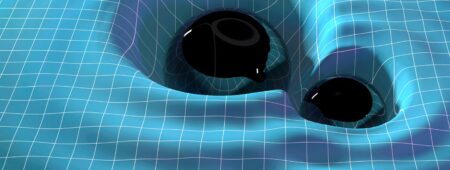
Using The Ticking of Pulsars to Probe the Universe
Scott Ransom credits a Hertz Fellowship with steering him toward an academic career studying pulsars, rotating stars that can act as ultra-precise clocks in the sky.
Every thirty-three milliseconds, the Crab Pulsar — a neutron star more than seven thousand light years away — spins on its axis and a beam of radiation sweeps over the Earth. Wait another thirty-three milliseconds and another “pulse” passes by, which scientists can detect through radio waves, visible light, X-rays or gamma rays.
In every direction, far-off pulsars are flashing beams of radiation toward the Earth, anywhere from 700 times a second to once every few seconds. Together, these pulsars provide ultra-sensitive clocks for measuring masses and forces in the depths of the universe.
For the last three decades, Hertz Fellow Scott Ransom has been studying pulsars; he has developed technology to detect pulsars, has discovered new ones, and has used their properties to address other questions. Recently, he was part of a team that used the spins of pulsars to study gravitational waves.
“The more I learn about pulsars, the more fascinated I become with them,” he says. “This field continues to provide tons of surprises.”
Growing up in a small Rust Belt town in Ohio, Ransom always loved astronomy. The thought of a career in academics, however, didn’t cross his mind; many people from his home town had served in the military and Ransom thought he might, after college, become an artillery officer. But as an undergraduate at the United States Military Academy at West Point, he became enamored with physics and was encouraged by a professor to apply for the Hertz Fellowship.
“The Hertz Fellowship really changed everything,” Ransom says. “It let me go to graduate school and focus on science, which wouldn’t have happened otherwise. It was really not planned.”
During graduate school at Harvard, Ransom intended to focus on a branch of physics with military applications, which could serve him well when he returned to the Army. He began building new infrared detectors — useful both for night vision and for astronomy (many of the most distant objects in the universe can be detected through infrared waves).
To make sure their sensitive infrared technology was working, Ransom and his advisor needed something in the night sky that emitted variable amounts of infrared. The Crab Pulsar was a natural choice.
“To analyze our data and test this instrument, I had to learn a lot about pulsars,” Ransom recalls. “And I started to become more intrigued with pulsars themselves than with the infrared detector side of my work.”
At the time, scientists only knew of a few pulsars, but suspected there must be tens of thousands more within our own galaxy. For his graduate thesis, Ransom developed a new suite of software to analyze radio wave data and discover new pulsars. That software, PRESTO, has been used to find more than 1000 new pulsars since it was first released.
In 2004, Ransom became both an astronomer at the National Radio Astronomy Observatory (NRAO) and a visiting research professor at the University of Virginia. The NRAO helps run all the major radio telescopes in the U.S. — vital tools for tracking pulsars. By measuring the timing of pulses sent out by dozens of pulsars, scientists like Ransom can infer things like the masses of other stars that the pulsars are in orbit with.
“We keep track of every single rotation of these pulsars over time, for many years,” says Ransom. “By doing that, it lets us measure very precisely how the pulsar is moving back and forth.”
One of his his most cited papers, he says, used a pulsar’s radio waves to determine the mass of an extremely heavy neutron star that was previously unmeasurable. Having more precise masses lets physicists calculate the extraordinary pressures at the centers of these incredibly dense stars and better understand the nuclear reactions that are occuring at their cores.
Since 2007, Ransom has helped lead NANOGrav, a group of scientists using pulsar timing to study gravitational waves — ripples in space-time that had long been hypothesized. The team tracked 67 pulsars for fifteen years and showed that the rhythms of the pulsars were indeed changed in ways consistent with gravitational waves. As the Earth imperceptibly jiggles from the passing of a slow gravitational wave, the energy from pulsars in one direction arrives slightly earlier and the energy from those in the opposite direction is slightly late.
“This tells us some really fundamental things, because we think these gravitational waves are coming from the most massive black holes in the universe,” says Ransom. “We think that when two large galaxies merge, the black holes at their centers start orbiting each other and that’s when they pump out these gravitational waves.”
But future data from NANOGrav hopes to clarify exactly where the gravitational waves are coming from and how they are produced. As scientists discover an ever-expanding number of pulsars, the new data will help answer those questions.
“The biggest challenge we have right now for pulsars is sensitivity. These pulsars are extremely faint sources of radio waves,” explains Ransom. “So we have to use the very, very biggest radio telescopes to find them. We still probably know of less than five percent of the pulsars in our galaxy.”
The 2020 collapse of the Arecibo radio telescope in Puerto Rico threw a wrench in the efforts to collect more pulsar data and Ransom is hoping new planned telescopes are constructed soon. Until then, he stays excited by the data coming out of the telescopes he helps manage, like the Green Bank Telescope in West Virginia.
“This is a really fun field that plays on my interests and strengths really beautifully,” he says. “I think there’s still a lot of potential for future discovery.”
